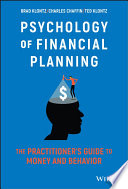Psychology of Financial Planning: The Practitioner’s Guide to Money and Behavior 1st Edition Brad Klontz
$50.00 Original price was: $50.00.$25.00Current price is: $25.00.
Psychology of Financial Planning: The Practitioner’s Guide to Money and Behavior 1st Edition – Ebook Instant Download/Delivery ISBN(s): 9781119983729,111998372X,9781119983736, 1119983738

Product details:
- ISBN-10: 1119983738
- ISBN-13: 9781119983736
- Author: Brad Klontz, Charles R. Chaffin, Ted Klontz
Given that Psychology of Financial Planning is now a required topic for both initial certification as well as Continuing Education, there are massive market opportunities for this book. There are over 200 educational institutions accredited by the CFP Board that graduate an estimated 5,000 students per year. PSYCHOLOGY OF FINANCIAL PLANNING has the potential to be the equivalent of an “Introduction to Psychology”-type textbook that every student in the field of financial planning must have. There will also be ongoing demand for periodic updates. In addition, there are over 92,000 CFP® professionals who will be looking for Continuing Education credits in the psychology of financial planning. This is an unprecedented market opportunity to create THE comprehensive resource in psychology and financial planning that acts as a companion to the existing textbooks covering the traditional core learning objectives in financial planning.
Table contents:
PART I: THE PSYCHOLOGY OF MONEY
CHAPTER 1: Financial Instincts: Why We Are Bad With Money
CHAPTER 2: Behavioral Finance: Understanding Cognitive Biases and Heuristics and What to Do About Them
CHAPTER 3: The Environment
PART II: UNDERSTANDING A CLIENT’S FINANCIAL PSYCHOLOGY
CHAPTER 4: Financial Flashpoints: Exploring a Client’s Financial Background
CHAPTER 5: Money Beliefs
CHAPTER 6: Financial Behaviors and Outcomes
PART III: PRINCIPLES OF COUNSELING, PSYCHOLOGY, AND COMMUNICATION
CHAPTER 7: Sources of Money Conflict
CHAPTER 8: The Principles of Effective Communication
CHAPTER 9: Solution‐Focused Techniques in Financial Planning
CHAPTER 10: Cognitive Behavioral Approaches in Financial Planning
CHAPTER 11: Positive Psychology in Financial Planning
CHAPTER 12: Working with Couples and Families: A Systems Perspective
PART IV: CLIENT AND PLANNER ATTITUDES, VALUES, AND BIASES
CHAPTER 13: Multicultural Competence in Financial Planning: Understanding Your Client’s Cultural Identity
CHAPTER 14: Financial Risk Tolerance
CHAPTER 15: Client‐Preferred Learning Styles: Getting and Keeping Your Client’s Attention
CHAPTER 16: Client Values and Goals
PART V: INTEGRATING FINANCIAL PSYCHOLOGY INTO FINANCIAL PLANNING
CHAPTER 17: Getting the Client to Take Action: Motivational Interviewing in Financial Planning
CHAPTER 18: Helping a Client in Crisis
CHAPTER 19: Assessment in Financial Planning
CHAPTER 20: The Role of the Financial Planner: Ethical Considerations in the Psychology of Financial Planning
People also search:
Psychology of Financial Planning
What is the physiology of financial planning
psychology used in finance
How do financial advisors use psychology
psychology affect financial decisions
You may also like…
Business & Economics - Personal Finance
Business & Economics - Industries
Business & Economics - Markets
Computers - Programming
Business & Economics - Personal Finance
Smart Money Strategy: Your Ultimate Guide to Financial Planning 1st Edition












